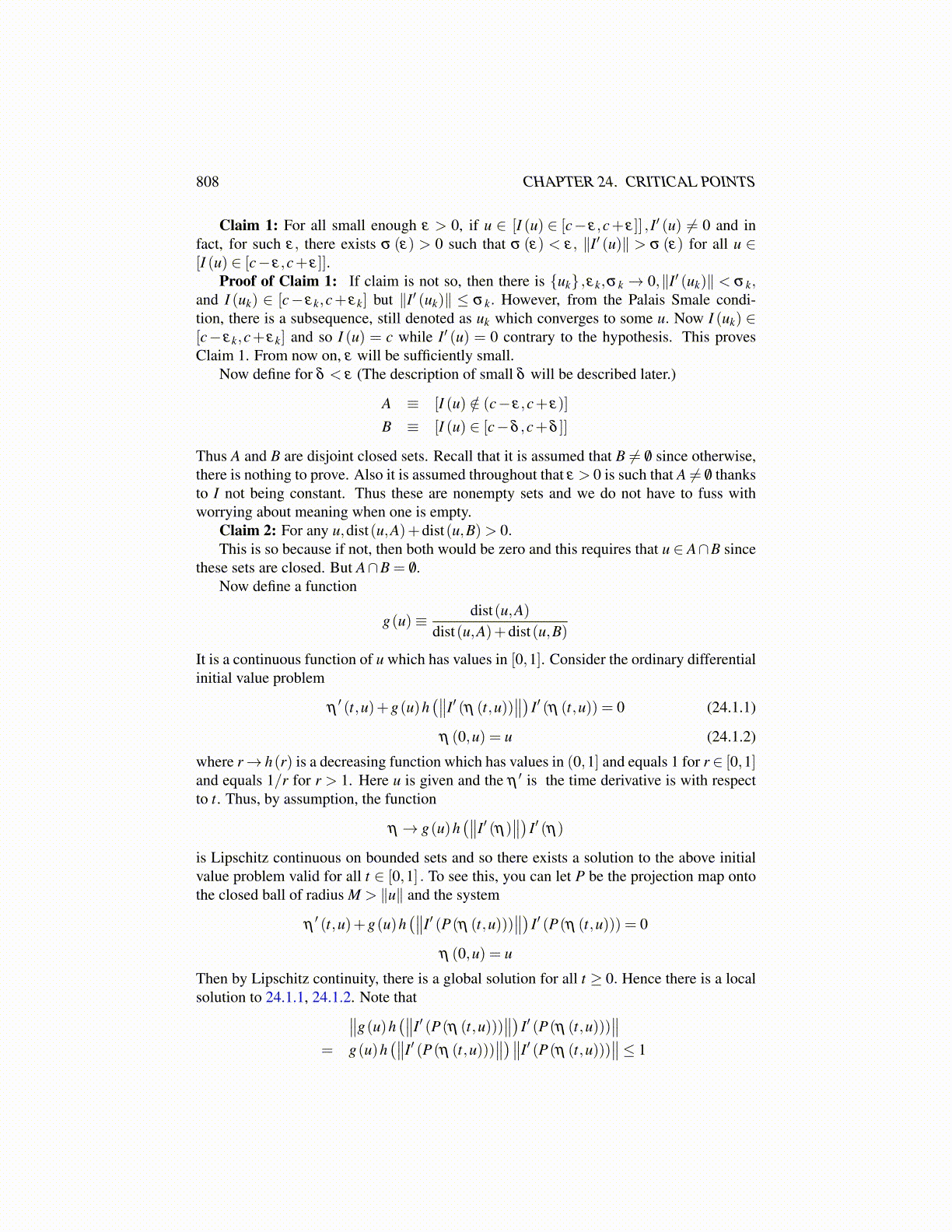
808 CHAPTER 24. CRITICAL POINTS
Claim 1: For all small enough ε > 0, if u ∈ [I (u) ∈ [c− ε,c+ ε]] , I′ (u) ̸= 0 and infact, for such ε, there exists σ (ε) > 0 such that σ (ε) < ε, ∥I′ (u)∥ > σ (ε) for all u ∈[I (u) ∈ [c− ε,c+ ε]].
Proof of Claim 1: If claim is not so, then there is {uk} ,εk,σ k → 0,∥I′ (uk)∥ < σ k,and I (uk) ∈ [c− εk,c+ εk] but ∥I′ (uk)∥ ≤ σ k. However, from the Palais Smale condi-tion, there is a subsequence, still denoted as uk which converges to some u. Now I (uk) ∈[c− εk,c+ εk] and so I (u) = c while I′ (u) = 0 contrary to the hypothesis. This provesClaim 1. From now on, ε will be sufficiently small.
Now define for δ < ε (The description of small δ will be described later.)
A ≡ [I (u) /∈ (c− ε,c+ ε)]
B ≡ [I (u) ∈ [c−δ ,c+δ ]]
Thus A and B are disjoint closed sets. Recall that it is assumed that B ̸= /0 since otherwise,there is nothing to prove. Also it is assumed throughout that ε > 0 is such that A ̸= /0 thanksto I not being constant. Thus these are nonempty sets and we do not have to fuss withworrying about meaning when one is empty.
Claim 2: For any u,dist(u,A)+dist(u,B)> 0.This is so because if not, then both would be zero and this requires that u ∈ A∩B since
these sets are closed. But A∩B = /0.Now define a function
g(u)≡ dist(u,A)dist(u,A)+dist(u,B)
It is a continuous function of u which has values in [0,1]. Consider the ordinary differentialinitial value problem
η′ (t,u)+g(u)h
(∥∥I′ (η (t,u))∥∥) I′ (η (t,u)) = 0 (24.1.1)
η (0,u) = u (24.1.2)
where r→ h(r) is a decreasing function which has values in (0,1] and equals 1 for r ∈ [0,1]and equals 1/r for r > 1. Here u is given and the η ′ is the time derivative is with respectto t. Thus, by assumption, the function
η → g(u)h(∥∥I′ (η)
∥∥) I′ (η)
is Lipschitz continuous on bounded sets and so there exists a solution to the above initialvalue problem valid for all t ∈ [0,1] . To see this, you can let P be the projection map ontothe closed ball of radius M > ∥u∥ and the system
η′ (t,u)+g(u)h
(∥∥I′ (P(η (t,u)))∥∥) I′ (P(η (t,u))) = 0
η (0,u) = u
Then by Lipschitz continuity, there is a global solution for all t ≥ 0. Hence there is a localsolution to 24.1.1, 24.1.2. Note that∥∥g(u)h
(∥∥I′ (P(η (t,u)))∥∥) I′ (P(η (t,u)))
∥∥= g(u)h
(∥∥I′ (P(η (t,u)))∥∥)∥∥I′ (P(η (t,u)))
∥∥≤ 1